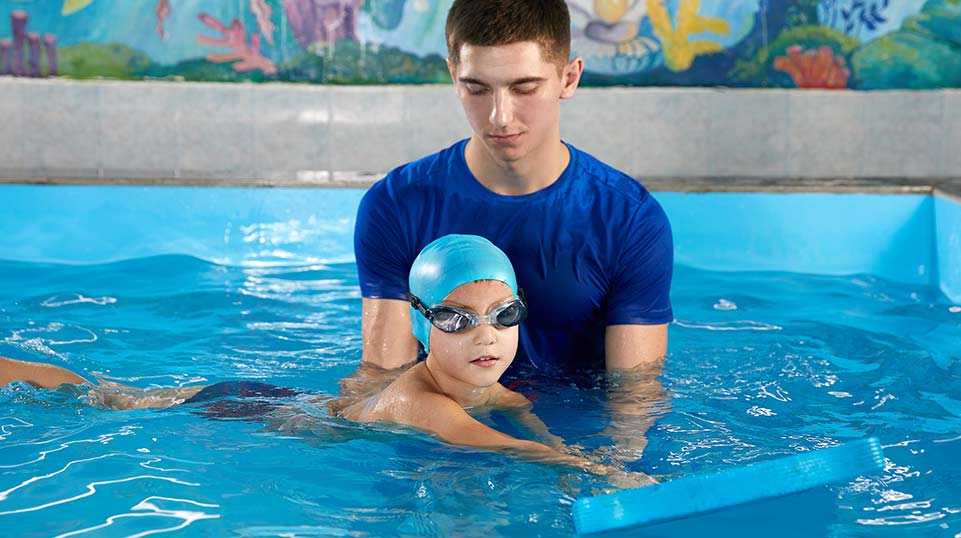With summer coming up, it’s time to start looking forward to all of the warm weather activities, and that includes swimming! Whether you might be visiting the beach, going to the pool, or simply enjoying water play in the backyard, it’s always important to consider water safety.
If your child has autism or other developmental or sensory differences, teaching swimming and water safety may be even more important. Children with autism face a higher drowning risk than their neurotypical peers.
While autism and sensory differences are discussed in this article, the information provided is inclusive for all families and applicable to parents of both autistic and neurotypical children. Our goal is to ensure that every child can safely enjoy the joys of swimming and water play this summer!
The Basics of Water Safety
Teaching water safety skills is important for all children. Children with autism and other developmental differences face unique challenges when it comes to swimming, which we’ll get into later in the article. To start, here are some general safety rules that everybody should follow:
- Constant Supervision
Always watch children when they are in or near water. This includes pools, bathtubs, lakes, oceans, and even small kiddie pools. Assign a responsible adult to supervise children around water at all times. This person should avoid distractions like phones or reading, and be solely focused on supervising.
- Wearing a Life Jacket
Ensure children wear U.S. Coast Guard-approved life jackets when in or around natural bodies of water or when boating. These life-saving devices are designed to keep a child afloat, providing crucial support even if they accidentally fall into the water or get caught in a current.
- Swimming Lessons
Enroll children in age-appropriate swimming lessons to teach them basic swimming skills and water safety. Enrolling your child in swimming lessons from a young age helps them acclimate to the water and learn swimming skills more easily.
- Teach Water Safety Rules
Teach children to follow water safety rules, such as no running near the pool, no diving in shallow water, and no swimming without adult supervision. While these skills are often taught in formal swimming lessons, it’s important to always reinforce them when around water.
- Wear Brightly Colored Swimwear
The color of your child’s bathing suit affects their visibility underwater for both you and lifeguards. Avoid blue, green, and gray swimwear; instead, choose neon yellow, hot pink, orange, or bright red for the best visibility.
- Avoiding Elopement
Children with autism are at a higher risk for elopement, or wandering away. This can be particularly dangerous in environments like parking lots, busy streets, or near pools and bodies of water. Teaching your child to stop when they hear someone say “stop” is an essential safety skill, as well as staying close to a parent or caregiver. ABA Therapy can be very effective in helping your child learn this and other important safety skills.
Swimming Challenges for Children with Autism
Autism can present unique challenges in the water, including difficulties with sensory processing, communication, and motor skills. These factors can make learning to swim and practicing water safety more complex.
Many children with autism experience sensory sensitivities, which can make the feel of water on their skin or the sounds and movements around a pool overwhelming. They may be under-sensitive or over-sensitive to the feel of water, which can lead to anxiety or reluctance to participate in swimming activities. Think about bathtime – does your child love to splash around in the water, or do they avoid it like the plague? Either way can pose unique challenges.
- Hyper-sensitive to water – These kiddos don’t like the feel of water and prefer to avoid it. They can also be very sensitive to the water’s temperature. The biggest challenge may be discovering your child’s particular sensory needs and gradually introducing them to the feel of water. This process should be done slowly with various desensitization and gradual exposure techniques.
- Hypo-sensitive to water – Kids who are hypo-sensitive to water tend to love splashing around and it can be hard for them to get out of the pool when it’s time to go. They may be overconfident in the water and unaware of potentially dangerous situations, such as submerging their face for longer periods. Before pool time, consider running through a sprinkler first to foster that excitement and energy before jumping into a larger body of water.
In addition to the sensory challenges associated with water, we can’t forget about the two “hidden senses” – proprioception and interoception. Both are essential in learning how to swim.
- Proprioception
This is the sense that allows us to know where our body is in space. Close your eyes and touch your nose with your finger. The ability to do this without looking is due to proprioception, which helps you sense the position and movement of your body parts. Children with low proprioceptive awareness may have trouble coordinating movements and balancing in the water. This can make floating a difficult skill to learn, as the sensation of being ungrounded can be disorienting.
- Interoception
Interoception, often referred to as the “hidden sense,” allows us to understand internal body cues. This sense helps you recognize when you’re hungry, tired, hot, cold, or fatigued. Children who struggle with interoception may have difficulty recognizing when their muscles are tired and they need to take a break or how to regulate their breathing when fatigued.
Communication differences may also make it harder for children with autism to understand instructions or signal distress. Motor skill challenges, such as poor motor planning, can also affect their ability to coordinate swimming movements.
There is also a strong visual component to swimming. Most pool liners blend in with the color of the water, making the boundaries of the pool difficult to understand. This can make jumping into the pool traumatic. Kids should never be forced into the pool before they are ready.
It’s important to keep in mind that swimming is tricky for all kids to learn, and every child learns at their own rate. With the right teacher and support, learning swim and safety skills should be fun! Luckily, there are plenty of options available to teach your child swim safety skills, tailored to their individual needs.
Where to Get Swimming Lessons for Special Needs Children
Depending on your child’s support needs, many group swim facilities have teachers who are trained in sensory and communication differences and can provide additional support and accommodations. These can include waterproof fidgets, visual aids, and working at whatever pace your child feels comfortable with.
Goldfish Swim School offers accommodations for special needs learners, Aqua-Tots has a Special Needs Aquatics Program (S.N.A.P.), and British Swim School offers a Special Abilities Program. These are just a few examples available in the Chicagoland area. Feel free to call your local swim school and speak with the manager to discuss your child’s needs.
You can also look into adaptive swimming lessons through your Special Recreation Association. Below are some in the Chicago Suburbs. You can view a complete list of Illinois towns and their Special Recreation Associations.
How ABA Therapy and Occupational Therapy Can Help With Swimming
Applied Behavior Analysis (ABA) and Occupational Therapy (OT) can both help teach kids the foundational skills needed to learn water safety and swim skills. Swimming can be extremely beneficial and regulating for children, when done safely. More importantly, water play is such a fun part of summer!
At Westside, all therapy is 1:1 and tailored to meet your child’s individual needs. Foundational skills that will help with swimming include:
- Sensory Processing
- Personal Safety
- Communication Skills
- Self-Help Skills
- Emotional Regulation
- Dealing with Transitions
- Attention and Focus
To learn more about ABA therapy or other Westside services, please click the link below or call us at (815) 469-1500 and our team will walk you through the process.







